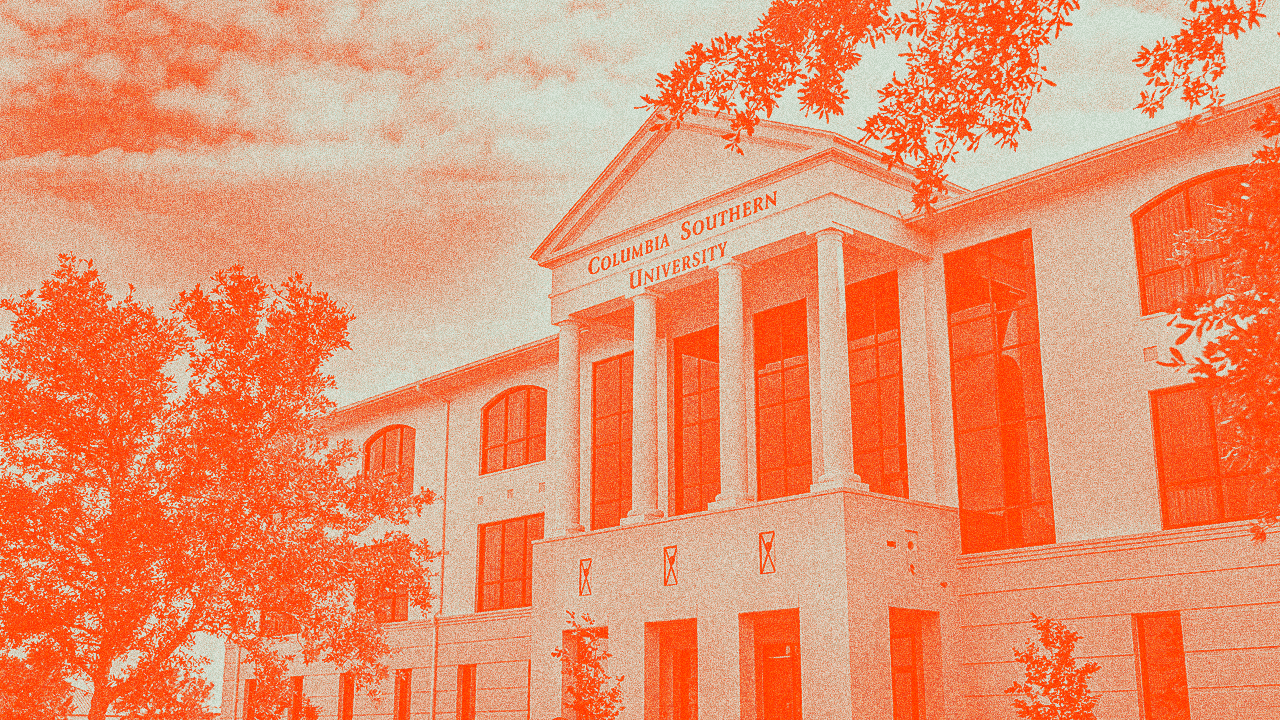The One Shift That Drove 16.6% Enrollment Growth at CSU

Columbia Southern University’s admissions teams had ambitions to evolve their approach to better align with the expectations of today’s digital-first students. Manual processes and disconnected tools made it challenging for advisors to manage communications efficiently and respond to prospective students with speed and personalization.
That’s when CSU brought in Mole Street to evolve their admissions process, shifting from manual workflows to a unified, performance-driven platform built for scale.
Solution
HubSpot Implementation
Industry
Higher Education
HubSpot Products
- HubSpot CRM
- Marketing Hub
- Sales Hub
- Operations Hub
Key Outcomes
- 16.6% increase in year-to-date enrollment conversion (2025)
- 18.2% year-over-year growth in application volume
- 74% increase in total call volume for new advisors (post-training)
- 73% increase in daily calls per advisor (from 63 to 109)
- 55% increase in average daily advisor talk time (from 1hr 32min to 2hr 24min)
1 minute 14 seconds

Cindy Chiribao
Associate Vice President of Admissions, Columbia Southern University
The Challenge
Manual Workflows That Capped Performance and Visibility
Before partnering with Mole Street, CSU relied on a homegrown SIS/CRM to manage all admissions activity. While effective in its original purpose, the legacy approach offered limited automation and segmentation. This prompted the team to explore new ways to support a more dynamic, digital-first enrollment journey.
Manual Outreach With Low Engagement
Advisors spent considerable time managing one-to-one texts and emails, handling unclaimed leads manually. Outreach was often delayed and lacked personalization, making it difficult to capture student interest. This resulted in an average response rate of just 10%.
As a consequence, this manual process:
- Delayed response times: Slowed follow-up on new inquiries
- Created workflow inefficiencies: Added friction to daily operations
- Lacked personalization: Offered no pre-call engagement or tailored messaging

Brian Belliveau
Chief Growth Officer, Columbia Southern University
26 seconds
Lack of Segmentation Made Targeting Challenging
Leads came in through digital ads, outreach events and website forms but were funneled into a one-size-fits-all engagement flow. There was no segmentation based on intent, source, or stage, resulting in uniform outreach regardless of lead context.
As a result:
- Outreach was less targeted: All leads received the same messaging, regardless of intent or source.
- Prioritization was limited: Advisors had no clear way to distinguish and focus on high-intent leads.
- Personalization was challenging: Follow-up couldn’t be tailored based on lead behavior, which impacted conversion potential.
Disconnected Systems Created Operational Gaps
CSU’s admissions team operated across multiple systems that didn’t communicate with each other:
- Internal CRM (Omega): Managed lead records but offered no automation
- RingCentral: Used separately for calls and manual SMS
- HubSpot: Underutilized—served only as a passive data mirror
Operating in separate systems made it difficult to maintain full visibility into the student journey.
As a result:
- Key stages like lead qualification and application progress weren’t tracked in one place
- Advisors lacked context for outreach or handoffs
- Engagement was fragmented, with no unified system to manage the full funnel
Manual Reporting With Limited Insight
All reporting was compiled manually, offering only basic visibility into top-line KPIs. Attribution data was limited, making it harder to pinpoint which campaigns or reps were driving results.

Cindy Chiribao
Associate Vice President of Admissions, Columbia Southern University
11 seconds
This made it difficult to:
- Track performance: Limited ability to measure advisor effectiveness
- Pinpoint drop-off: No clear view of where leads exited the funnel
- Optimize strategy: Difficulty determining which campaigns or content were driving inquiries
Staff Strain and Scalability Issues
Outreach and follow-ups were done manually. Consequently, maintaining daily operations required significant advisor time for repetitive tasks, limiting bandwidth for strategic work. This left minimal capacity for strategic initiatives or growth. The technology wasn’t lifting the workload; it was adding to it.
- High operational load: Advisors spent significant time on repetitive administrative tasks
- Inefficient scalability: Growth depended on additional effort—not smarter systems
- Limited strategic capacity: Teams lacked the bandwidth to focus on high-impact initiatives
Attribution Blind Spots Limited Strategic Decisions
CSU saw an opportunity to improve attribution and better understand which channels were driving results. Without a centralized, trackable view of campaign performance, the admissions team was forced to rely on anecdotal insights or broad KPIs—undermining their ability to optimize efforts in real time.
This made it difficult to:
- Identify top-performing campaigns or channels
- Justify marketing spend and adjust in real time
- Focus outreach on the most promising lead sources
The Business Impact of a Disconnected Admissions Infrastructure
- Advisor productivity was constrained: Manual outreach workflows limited efficiency, with reps averaging just 63 calls per day prior to implementation.
- Engagement opportunities were missed: Uniform outreach led to generic messaging and a connection rate of just 10%.
- Limited behavioral insight: Advisors lacked visibility into which pages prospects viewed or interacted with—making personalization and pre-call context more difficult.
- Time-intensive messaging: Follow-up emails and texts were sent manually after each call, often requiring reps to select templates one by one.
- Fragmented tools and tracking: Key stages like lead qualification and application progress weren’t tracked in a single system, leading to inconsistent handoffs.
- Minimal reporting and attribution visibility: Without unified reporting, it was challenging to measure campaign impact or identify what was driving results.
- High effort, low efficiency: Manual processes stretched advisor capacity, requiring extra effort to keep pace with enrollment goals.
- Limited agility in operations: Without flexible automation or segmentation, it was difficult to quickly adjust campaigns or re-engage prospective students.
The Goal - Automate Outreach, Unify Data and Improve Speed-to-Lead
The overarching goal was to modernize and streamline CSU’s admissions operations by shifting from a manual, fragmented process to a more agile, scalable system. To achieve this, the primary objective was to transition CSU’s existing SIS/CRM (Omega) workflows into HubSpot without disrupting daily operations.
This meant building the infrastructure to:
- Increase advisor productivity
Free up reps from repetitive administrative tasks so they could spend more time engaging students and less time clicking through manual workflows. - Improve speed-to-lead
Accelerate the time between inquiry and first contact by automating outreach and reducing the number of steps between lead capture and advisor action. - Enhance personalization at scale
Segment leads by behavior, source and program of interest to deliver more relevant, timely communication and guide better conversations. - Centralize admissions data
Create a single source of truth for outreach, engagement and lead progression—from initial inquiry to enrollment. - Strengthen reporting and attribution
Enable real-time visibility into campaign performance, rep activity and conversion points to support continuous optimization. - Support scalable growth
Lay a flexible foundation that could evolve with CSU’s enrollment strategy and empower teams to launch campaigns without IT dependency.
The Solution - A Phased CRM Implementation Tailored to CSU’s Workflow
Mole Street delivered a full HubSpot CRM implementation to empower CSU with a more efficient, scalable admissions process. The engagement followed a phased rollout model, starting with core workflows and progressively expanding automation, segmentation and visibility—without disrupting day-to-day operations.

Automated Engagement Workflows
Workflows were designed around real-world student journeys—from inquiry to application. Mole Street built logic that automated emails and SMS sends based on call outcomes and timing, eliminating manual message selection and reducing advisor effort.

Smart Segmentation and Lead Assignment
Leads were no longer treated equally. Mole Street implemented segmentation by behavior, program interest and lead source—allowing advisors to prioritize outreach and tailor communication accordingly.

Strategic Integration with CSU's Legacy CRM
Rather than a rip-and-replace approach, Mole Street layered HubSpot on top of CSU’s homegrown SIS (Omega). This enabled key workflows to transition incrementally, giving CSU the confidence to adopt new systems without risking disruption.

Collaborative Journey Mapping
The Mole Street team facilitated collaborative sessions to map CSU’s student lifecycle, identify friction points and design workflows aligned with how HubSpot naturally works.

Brian Belliveau
Chief Growth Officer, Columbia Southern University
27 seconds

Training and Internal Enablement
Hands-on sessions empowered CSU’s admissions team to manage workflows, create campaigns and iterate independently. What once required IT and multiple departments could now be executed by individual advisors—unlocking day-to-day agility and long-term ownership.

Built for Future Scale
With foundational systems in place, CSU is now positioned to expand automation, explore AI prospecting and scale outreach without increasing overhead—making HubSpot not just a tool, but a platform for sustainable growth.
Results - Faster Outreach, Smarter Operations and Measurable Growth
Prior to partnering with Mole Street, CSU was bogged down by disconnected systems that forced a cumbersome, inefficient approach to admissions. Teams were left heavy-footed—juggling manual tasks, delayed outreach and limited visibility across the funnel.
Now, CSU is empowered with maximum operational agility—reflected in a 70% increase in daily advisor call activity. It’s a transformation that has rippled to all corners of the institution.

Cindy Chiribao
Associate Vice President of Admissions, Columbia Southern University
|
Metric |
Before Mole Street |
After HubSpot Implementation |
|
Daily Calls per Advisor |
~63 calls |
~109 calls (+70%) |
|
Talk Time per Advisor |
1 hour 32 minutes/day |
2 hours 23 minutes/day (+55%) |
|
Call Volume (New Hires, 2 Weeks) |
2,450 total |
4,252 total (+74%) |
|
Email Campaign Impact |
Campaigns required IT and cross-team coordination |
122 enrollments from 1 campaign—launched by an advisor |
|
Outreach Workflow |
Manual, one-by-one emails/texts |
Automated, behavior-based sequences |
|
Speed-to-Lead |
Delayed by manual handoffs |
Real-time follow-up workflows triggered by lead actions |
|
Reporting & Attribution |
Manual, surface-level metrics |
Real-time visibility into advisor, campaign and funnel performance |
|
Enrollment Conversion Rate |
Baseline |
+16.6% YTD increase |
Centralized Admissions Infrastructure
Mole Street’s phased HubSpot CRM implementation unified CSU’s disconnected systems into one cohesive platform.
✔ Eliminated manual handoffs and tool-switching across admissions workflows
✔ Enabled a complete view of the student journey—from inquiry through enrollment
✔ Created a scalable, data-driven foundation for future growth and agility
Increased Advisor Efficiency
Automation freed CSU advisors from repetitive admin work, allowing them to focus on meaningful conversations that move students forward.
✔ Daily call volume per advisor increased by 70% (from ~63 to 109 calls)
✔ Talk time rose 55%, from 1h32m to 2h23m per advisor
✔ New hires made 74% more calls in their first two weeks (4,252 vs. 2,450)
✔ Productivity gains were achieved without increasing headcount
Internal Enablement and Autonomy
Hands-on training and intuitive systems allowed CSU’s team to take full ownership of their campaigns.
✔ A single advisor launched two email campaigns independently—driving 122 new enrollments
✔ Campaigns no longer require IT or interdepartmental coordination
✔ The team can now launch, adapt and optimize workflows on their own
Faster, More Personalized Communication
HubSpot’s automation and segmentation capabilities transformed the timing and relevance of outreach.
✔ Advisors engage leads faster, with real-time follow-ups triggered by student behavior
✔ Outreach is now tailored by lead source, interest and stage
✔CSU built a speed-to-lead engine aligned with the expectations of today’s digital-first learners
Real-Time Insights with Breeze Copilot
Breeze Copilot gives CSU advisors a real-time summary of each student’s activity: pages viewed, meetings scheduled and communication history. This eliminates the need to dig through notes and enables faster, more personalized outreach.
✔ Eliminate pre-call guesswork and manual context gathering
✔ Strengthen personalization and connection quality
✔ Speed up advisor response times
Hidden Costs and Cumbersome Customizations
The CRM was heavily customized with over 60 custom objects to manage both B2B and B2C processes. This complexity required substantial manual work to manage, placing a heavy burden on the team as they struggled to navigate unnecessary challenges.
Additionally, every customization, new feature, or additional support request seemed to have hidden costs, making it more challenging to manage their budget predictably.
Misfiring Campaigns and Data Blind Spots
The limited segmentation and automation features hindered WVDT’s ability to personalize its marketing efforts. Consequently, WVDT was forced to create broad campaigns that failed to maximize its marketing potential.
Creating marketing emails was cumbersome due to the complex interface and limited flexibility. This required external support, further complicating the workflow.
Moreover, Salesforce Marketing Cloud lacked integrated tools and features necessary for real-time analytics and detailed tracking. As a result, WVDT could not keep its finger on the pulse of user interactions. With no metrics to guide them, WVDT was flying blind in their marketing.
Poor User Experience and Increased Workload
WVDT’s B2B portal was outdated and dysfunctional. This created a barrier that prevented users from accessing vital information, managing advertising campaigns, as well as engaging with the Tourism Board.
Although the portal was built on a reliable CMS, it was dependent on receiving data from Salesforce custom objects. Consequently, this made the system rigid and awkward to use which provided limited control over the design and user experience.
Enhanced Visibility and Strategic Oversight
With centralized, actionable data, CSU’s leadership team can now make smarter, faster decisions.
✔Clear attribution shows which campaigns, reps and channels drive results
✔Funnel drop-offs and engagement trends are now easy to identify and act on
✔Reporting is real-time and fully self-serve
✔Overall enrollment conversion is up 16.6% YTD, reflecting the downstream impact of operational improvements










